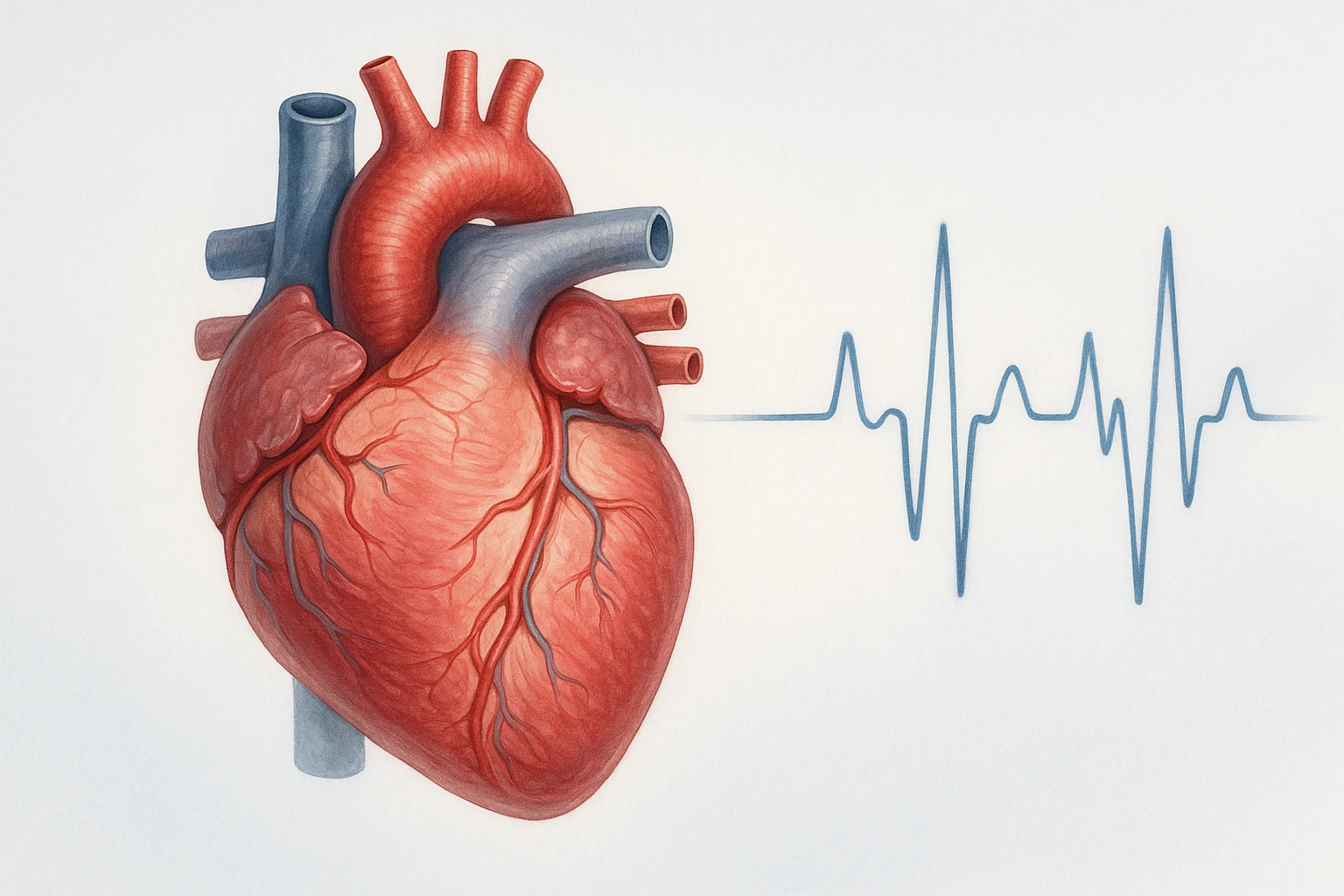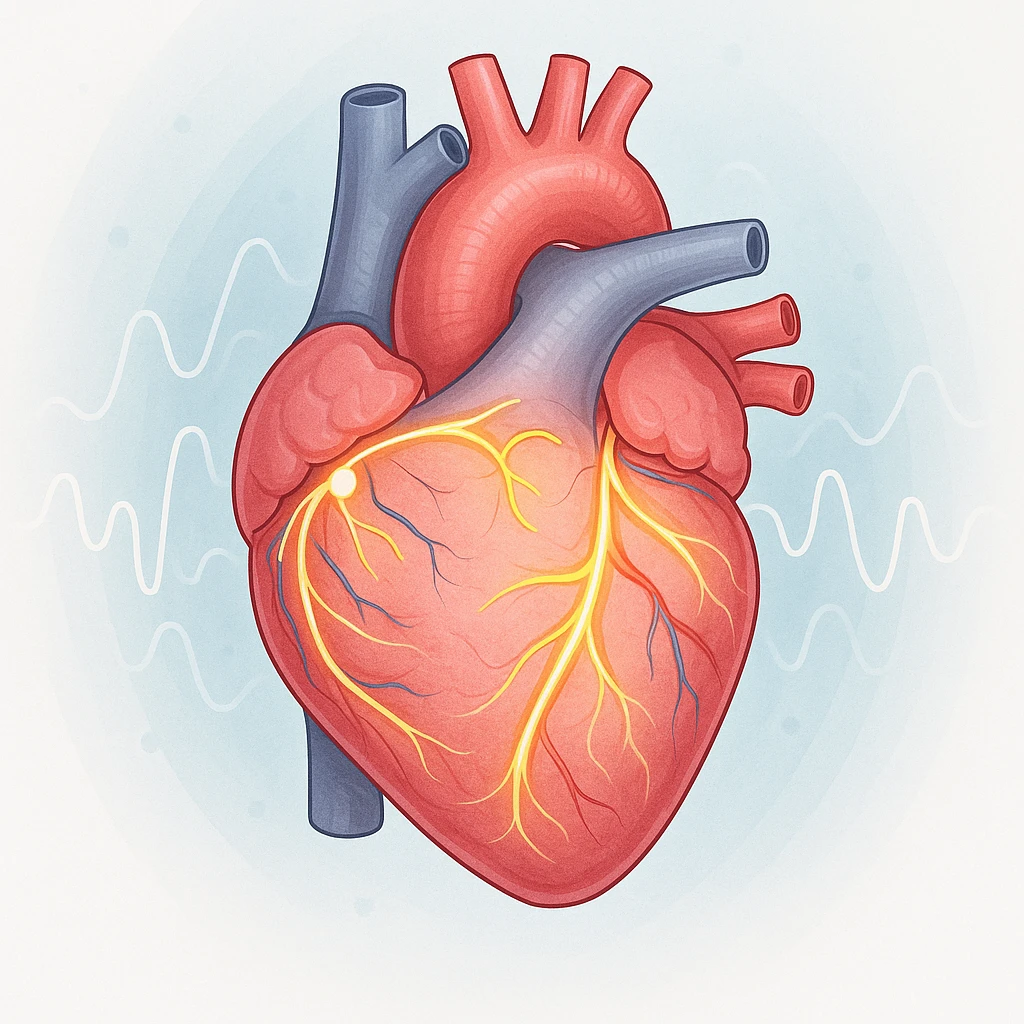Managing Chest Tightness When Lying Down: Diagnosis and Treatment
Chest Tightness When Lying Down: Definition and Mechanisms
Feeling tightness or pressure in the chest while lying down can be unsettling, and for clinicians, it is an important positional symptom that narrows the diagnostic field. This discomfort may reflect mechanical or physiological changes that occur when the body is supine, influencing cardiac, respiratory, or gastrointestinal systems. Understanding how posture alters normal physiology helps explain why chest tightness when lying down can emerge or intensify in certain positions.
Definition and Clinical Context
Orthopnea refers to shortness of breath or a sensation of chest tightness that develops when lying flat and typically improves upon sitting or standing. It often reflects underlying circulatory or pulmonary congestion that becomes evident only when gravity no longer assists venous return. Another important positional symptom is pericarditic chest pain, which is classically sharp and pleuritic. Unlike muscular or reflux pain, this discomfort worsens when lying down and tends to ease when sitting up or leaning forward, due to reduced pressure on the inflamed pericardial layers.
- Orthopnea: Breathing discomfort or tightness when lying flat, relieved by sitting or standing.
- Pericarditic pain: Sharp, pleuritic pain that worsens in the supine position and improves when sitting forward.
Recognizing these distinctions is clinically valuable because the patient’s position and timing of symptoms provide direct insight into the potential organ system involved. Relief upon elevation of the torso may indicate early signs of heart failure or pericardial inflammation rather than muscle strain or anxiety-related discomfort.
Mechanistic Overview
When the body assumes a horizontal posture, several physiological changes occur. In individuals with heart failure, lying flat increases venous return to the heart and raises pulmonary capillary pressure. The resulting accumulation of fluid in the lungs leads to a sense of heaviness or chest tightness-hallmark features of orthopnea. This mechanism reflects the heart’s reduced ability to manage increased preload when the effects of gravity are minimized.
Similarly, conditions outside the heart can produce chest tightness through postural effects. In gastroesophageal reflux disease (GERD), recumbency allows stomach acid to flow more easily into the esophagus because gravity no longer helps keep gastric contents in place. This can create burning discomfort or a pressure-like sensation behind the sternum, especially after meals. Together, these mechanisms demonstrate that chest tightness when lying down is not a single disease but a shared symptom arising from the body’s altered physiological state in the supine position.
Physiological Mechanisms and Major Causes of Chest Tightness When Lying Down
Chest tightness that appears or worsens in the supine position can arise from several physiological systems. Each system-cardiac, pulmonary, gastrointestinal, or musculoskeletal-contributes differently based on how posture alters internal pressures and organ interactions. Understanding these mechanisms helps clinicians distinguish benign from potentially serious conditions.
Cardiac and Pulmonary Mechanisms
Cardiac conditions are among the most clinically significant causes of chest tightness when lying down. In heart failure, recumbency increases venous return to the heart, leading to pulmonary congestion and a sensation of pressure or breathlessness known as orthopnea. The heart’s inability to handle this increased preload results in elevated pulmonary capillary pressure and reduced lung compliance, producing discomfort that resolves when the patient sits up.
Pericarditis involves inflammation of the pericardial layers surrounding the heart. The inflamed tissues become more sensitive to pressure changes, and lying flat increases discomfort as the heart presses against the irritated pericardium. Pain typically sharpens with deep breathing or coughing and improves when the patient leans forward, distinguishing it from ischemic pain.
Pulmonary disorders such as chronic obstructive pulmonary disease (COPD) and pulmonary hypertension also provoke positional tightness. When lying down, these conditions can exacerbate dyspnea due to decreased diaphragmatic movement and altered pulmonary perfusion, contributing to the feeling of chest heaviness or compression.
- Cardiac causes: Heart failure, pericarditis, and ischemic pain.
- Pulmonary causes: COPD, pulmonary hypertension, and reduced diaphragmatic motion when supine.
Gastrointestinal and Musculoskeletal Influences
Among gastrointestinal causes, gastroesophageal reflux disease (GERD) is the most common contributor to chest discomfort in the supine position. Recumbency reduces the protective effect of gravity, allowing acidic stomach contents to reflux into the esophagus. The resulting irritation can produce a burning or tight sensation behind the sternum, often mistaken for cardiac pain, especially after eating or at night. Esophageal motility disorders may also worsen in this position, adding to the sensation of chest pressure.
Musculoskeletal and anxiety-related factors can cause similar sensations but are typically less influenced by posture. Muscle strain or costochondritis produces localized tenderness that is reproducible on palpation, while anxiety-related chest tightness tends to occur independently of body position and fluctuates with stress levels. These distinctions are essential in clinical evaluation, preventing unnecessary cardiac investigations when symptoms follow a non-organic pattern.
| Category | Typical Mechanism | Positional Effect |
|---|---|---|
| Cardiac | Fluid redistribution and pericardial inflammation | Worse when lying flat, improved sitting up |
| Pulmonary | Impaired ventilation and pulmonary pressure increase | Exacerbated by reduced diaphragmatic motion |
| Gastrointestinal | Reflux of acidic contents into esophagus | More frequent after meals or at night |
| Musculoskeletal/Anxiety | Localized tenderness or stress-induced tension | Usually independent of posture |
Myths vs Facts
It is a common misconception that chest tightness at night always signifies a heart problem. In reality, while cardiac causes must always be ruled out, many cases are related to reflux or benign positional effects. Conversely, mild or intermittent symptoms should not automatically be dismissed as non-cardiac, as subtle posture-related discomfort can reveal early signs of heart failure or pericardial inflammation. Recognizing the interplay between systems allows for more accurate diagnosis and timely management.
Recognizing Clinical Patterns and Associated Symptoms
Chest tightness that changes with body position provides valuable diagnostic clues. By observing how pain behaves with posture, timing, and related sensations, clinicians can often identify whether the source lies in the heart, lungs, or gastrointestinal tract. Recognizing these patterns supports accurate differentiation between cardiac and non-cardiac causes of discomfort when lying down.
Characteristic Pain Profiles
- Pericarditic pain: Sharp, stabbing discomfort located retrosternally or along the left chest. Worsens when lying flat or with deep inspiration and improves when sitting up or leaning forward.
- Orthopnea: Sensation of tightness or breathlessness within minutes of lying down, relieved when the upper body is elevated. Patients often report needing multiple pillows to sleep comfortably.
- GERD-related discomfort: Burning or squeezing sensation behind the sternum, often postprandial or nocturnal. Worsens when supine and may improve with antacids or positional changes.
Associated Symptoms
| Condition | Common Associated Features |
|---|---|
| Pericarditis | Mild fever, fatigue, and positional chest pain that improves when leaning forward. |
| Heart failure (orthopnea) | Nocturnal cough, paroxysmal dyspnea, peripheral edema, and need for elevated sleeping position. |
| GERD | Sour taste, regurgitation, and discomfort after large meals or when lying flat at night. |
By contrasting these associated features, clinicians can better discern whether chest tightness when lying down arises from cardiac congestion, reflux-related irritation, or less serious positional effects. Attention to accompanying signs refines diagnostic accuracy and guides appropriate evaluation.
Clinical Evaluation and Red Flags for Chest Tightness When Lying Down
Evaluating chest tightness that occurs when lying down requires a systematic, symptom-focused approach. Because positional chest discomfort can reflect a range of cardiac, pulmonary, or gastrointestinal disorders, clinicians prioritize identifying life-threatening causes while distinguishing benign patterns through careful assessment.
Structured Diagnostic Approach
The clinical evaluation begins with a detailed history emphasizing how posture influences symptoms. Questions typically explore whether discomfort worsens when supine and improves when upright, whether it follows meals, and whether pain has a pleuritic or exertional component. Temporal patterns-such as nocturnal onset or symptoms immediately after eating-can help differentiate between cardiac and gastrointestinal origins.
- Key history questions: Relationship of pain to posture, meals, and exertion; presence of pleuritic features or nocturnal symptoms.
- Physical examination focus: Vitals, jugular venous pressure, peripheral edema, pulmonary findings, and pericardial friction rub.
- Initial investigations: ECG, cardiac biomarkers, chest radiograph, and targeted labs; echocardiography when cardiac dysfunction is suspected.
Physical findings help determine whether the underlying process is cardiac, pulmonary, or inflammatory. Objective testing refines the differential diagnosis and guides urgent versus routine management decisions.
Red Flags
Certain features of chest tightness require immediate medical attention. New, severe, or progressive pain at rest can signal acute coronary syndrome, pericardial effusion, or pulmonary embolism. Likewise, chest tightness accompanied by shortness of breath, lightheadedness, or collapse indicates possible hemodynamic instability.
| Red Flag | Clinical Implication |
|---|---|
| Severe, persistent, or escalating chest pain at rest | Possible acute coronary or pericardial event |
| Syncope or presyncope | Suggests hemodynamic compromise or arrhythmia |
| Signs of heart failure (orthopnea, edema, rapid weight gain) | Indicates decompensated cardiac function |
| Hypotension, cyanosis, or confusion | Reflects systemic instability requiring emergency care |
These red flags warrant urgent evaluation in an emergency setting, as they may reflect evolving cardiac or respiratory failure. Prompt identification of high-risk features ensures timely diagnostic testing and appropriate management.
Management, Prevention, and Prognosis of Chest Tightness When Lying Down
Management of chest tightness when lying down focuses on addressing the underlying condition while providing interim relief and preventing recurrence. Because this symptom can result from both benign and serious causes, care is individualized and guided by the specific physiological mechanism identified during evaluation.
Condition-Specific Management
| Underlying Cause | Typical Treatment Approach |
|---|---|
| Pericarditis | Anti-inflammatory therapy to reduce pericardial inflammation. |
| Heart Failure | Diuretics and medications to relieve fluid overload and improve cardiac output. |
| Gastroesophageal Reflux Disease (GERD) | Acid-suppressive therapy combined with dietary and lifestyle modification. |
| Pulmonary Disorders (e.g., COPD, Pulmonary Hypertension) | Inhaled therapies and treatment of underlying pulmonary pressure imbalance. |
Urgent assessment is warranted whenever cardiac or pulmonary causes are suspected. Symptom relief during evaluation often includes simple measures such as elevating the head of the bed or using additional pillows to reduce thoracic pressure and improve breathing comfort. These positional adjustments are particularly helpful in patients with orthopnea or reflux symptoms and can provide temporary relief while definitive treatment is initiated.
Preventive Measures and Prognosis
- Avoid late-night meals and alcohol intake to reduce reflux-related discomfort.
- Maintain healthy body weight and regular physical activity for cardiovascular health.
- Adhere to prescribed medications and schedule regular follow-up visits for monitoring.
- Control blood pressure, cholesterol, and pulmonary function to prevent recurrence.
Prognosis varies depending on the underlying cause but is generally favorable with early identification and appropriate therapy. Pericarditis and reflux-related chest tightness often resolve with treatment, while heart failure or chronic pulmonary conditions may require ongoing management and monitoring. With adherence to therapy and preventive measures, most patients experience significant symptom improvement and a stable long-term outlook.
Questions to Ask Your Clinician
- What underlying condition might be causing my chest tightness when lying down?
- Are there specific warning signs that should prompt an urgent visit or emergency care?
- Which lifestyle adjustments or sleeping positions can help reduce symptoms?
- How often should I schedule follow-up evaluations to monitor my progress?
Open communication with healthcare providers ensures that treatment plans are tailored to each patient’s condition and that any concerning changes are addressed promptly.
Frequently Asked Questions About Chest Tightness When Lying Down
- Why does chest tightness feel worse when I lie down?
- Lying flat increases blood flow to the chest and may raise pressure in the heart or lungs. It can also allow acid reflux to move upward, causing discomfort or tightness.
- Is chest tightness when lying down always a heart problem?
- Not always. While heart failure and pericarditis can cause this symptom, reflux disease, lung conditions, or even muscle strain can produce similar sensations.
- How can I tell if my symptoms are from reflux rather than my heart?
- Reflux discomfort often feels like burning behind the breastbone and tends to worsen after meals or at night, while cardiac pain may be pressure-like and linked to exertion.
- What symptoms mean I should seek urgent medical attention?
- Sudden, severe, or persistent chest pain at rest, fainting, shortness of breath, or bluish discoloration are red flags that need immediate emergency care.
- Can sleeping position affect chest tightness?
- Yes. Elevating the upper body helps reduce pressure in the lungs and limits acid reflux, which can ease positional tightness or breathlessness during rest.
- What tests help diagnose the cause of chest tightness when lying down?
- Doctors may use an ECG, chest X-ray, cardiac biomarkers, or echocardiography to evaluate heart and lung function and identify underlying problems.
- Are anxiety or stress ever related to this symptom?
- Emotional stress can cause a sensation of tightness in the chest, but it typically does not depend on posture and improves with relaxation or breathing exercises.
- What lifestyle habits can reduce recurrence of chest tightness when lying down?
- Maintaining a healthy weight, avoiding large late-night meals, and following prescribed medications for heart or lung conditions can help prevent symptom recurrence.
- Does chest tightness when lying down go away on its own?
- In some mild cases, it can resolve with posture adjustments or reflux management. However, persistent or worsening symptoms require medical evaluation to rule out serious causes.
- Can heart failure cause chest tightness only when lying flat?
- Yes. In heart failure, fluid shifts toward the lungs in a flat position, leading to shortness of breath and pressure that improve when sitting or propping up with pillows.













